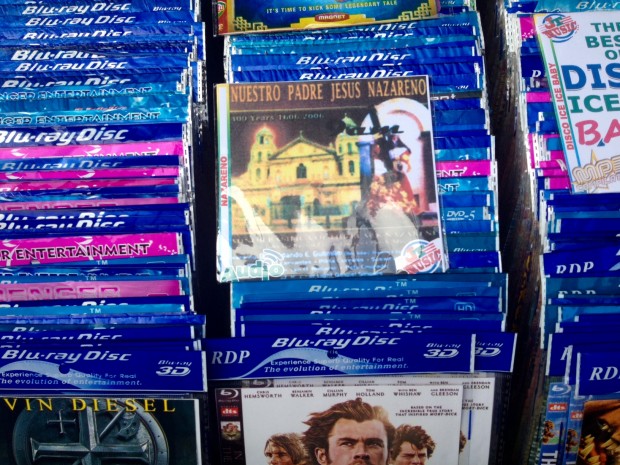
A copy of CD compilation featuring Nuestro Padre Jesus Nazareno being sold in Quiapo, Manila. ANTHONY Q. ESGUERRA/INQUIRER.net
Devotees who join the annual traslacion on the Feast of the Black Nazarene can’t seem to have enough of “Nuestro Padre Jesus Nazareno,” the official anthem of this devotion.
Composed by the late National Artist for Music Lucio San Pedro, the hymn is sung or played on loop during the hours-long procession of the 17th century image, until it enters Minor Basilica in Quiapo, Manila.
Even members of the media covering the event have reported hearing the song continuously inside their head, an indication of LSS (last song syndrome).
But it seems devotees still can’t get enough of the hymn, as pirated CD copies of the iconic anthem and other religious songs like “Poong Nazareno” and “Lumang Krus” enjoy brisk sales on the busy streets of Quiapo.
It’s their bestseller for the week, said vendors of pirated CDs and DVDs in the area, who play the song on a loop to attract more buyers.
“I’ve sold around 30 copies,” said one vendor who’d rather go with the alias Roger, for fear of being prosecuted for his illegal trade.
Earning P20 for every CD sold, Roger said the brisk sales are an indication that he has God’s blessings for selling the songs to devotees of the Black Nazarene.
‘True devotees’
“It is also my way of showing my devotion,” the 29-year-old said, adding, however, that other sellers who are “true devotees” of the Nazarene get to sell more.
“See that arm tattoo? A sure indication that they are devotees,” Roger said.
But no, he’d rather not get the same tattoo, as he is already happy with his sales, the vendor added.
His only prayer to the Nazarene, Roger said, is “good health for my family.”
Some buyers of the pirated CD credit the song for touching their soul.
Said 64-year-old devotee Dr. Ma. Remedios Ressuccion, who bought a copy: “I like it. The melody is nice. The songs are very touching.”
But most buyers insist on having their pirated “Nazareno” CD tested before buying them. Even faith has its limits, it seems.
Eye contact
It’s all in the wrist—and how you make eye contact, said Robert Fetizanan, a 47-year-old senior bank manager who joined this year’s traslacion and shared tips on how to throw towels or handkerchiefs to the Black Nazarene hijos and have them wipe the articles of clothing on the sacred image.
“I had to practice my throw around 100 times before I joined my first traslacion. The effort was worth it, because my handkerchiefs get blessed,” he said.
Eye contact with the hijos was also important, he said. “Make sure you make eye contact so the hijo will look for you in the crowd when he throws your handkerchief back. If you haven’t made eye contact, don’t throw your cloth!”
Fetizanan said he has been joining the traslacion for the past three years because he sees the event as one big miracle made up of many small miracles.
“The crowd is huge and people come from different walks of life. You would think it a dangerous event, but when you are here, you see how people help one another,” he said.
He recalled how he once thought he had lost the handkerchief he had thrown to a replica to be blessed because his timing was off; the carriage had already rolled past him. However, he was pleasantly surprised when a small child came running after him to return his keepsake.
Claustrophobic
Fetizanan’s wife Ping, 43, shared the same sentiment as her husband’s. Being claustrophobic, she said she was initially afraid the thick crowd might be too overwhelming for her.
“But when I finally joined him two years ago, I did not feel that at all,” she said.
Since he started joining the procession, Fetizanan said he has made it a point to take a leave from work to allot a whole day to the Nazarene, praying for good health and stronger relationships, especially in their marriage.
“If we can take leaves for birthdays or vacations, then we should be able to take time off work to give him our thanks,” he added.
Symbolic
Risking getting crushed in that tightly packed crowd is totally worth it, said several devotees who said their prayers to the Nazarene center on good health, economic security and education for their children.
“It is symbolic for me. Despite the difficulties and the risks of getting hurt, you are able to touch him,” said Gina Lopez, a mother of three, who is from Sta. Ana, Manila.
That touch would hopefully convert her husband, a gambler, into a vice-free life, said Sheryl, a 47-year-old government employee.
Other devotees squeeze themselves into the frenzied crowd as a sign of gratitude for answered prayers.
Joey Chavez, 44, said he suffered TB meningitis that paralyzed half of his body when he was an infant. But his parents did a nine-day novena to the Nazarene and joined the procession to pray for a cure. He has since recovered, the Tondo resident said.
Johnny Aguila, 65, spoke of a similar miracle when the Black Nazarene helped him recover the use of his arms. Doctors could not tell what ailed him, he said. But without any medical treatment—only faith in the Nazarene—the pain in his arms slowly faded.
“(God) is the only one I can be with and talk to. I no longer have a family,” said Bobby Yabut, 58, who was limping at the tail-end of the procession with a bandage around his kneecap, sustained injuries from a bike accident last month. Reports from Niña P. Calleja and Annelle Tayao-Juego